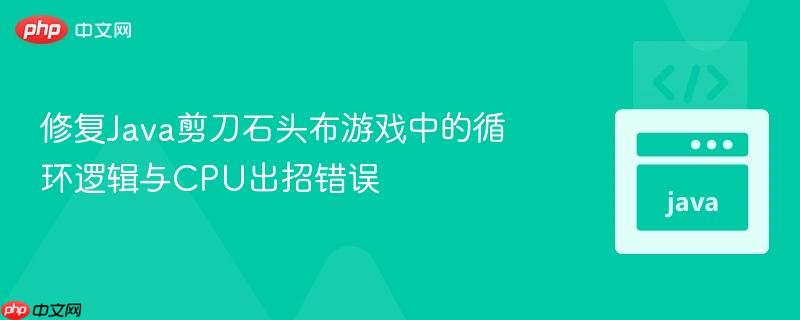
本教程旨在解决java剪刀石头布游戏中两个关键问题:一是平局时游戏无限循环,因主方法未正确更新游戏状态布尔变量;二是cpu出招逻辑缺陷,导致剪刀永不出现。文章将详细分析问题根源,提供代码修正方案,并强调函数返回值利用和随机数生成的正确实践,以构建一个功能完善、逻辑清晰的游戏程序。
在开发Java剪刀石头布游戏时,我们常常会遇到一些看似细微但影响程序逻辑的关键问题。本文将深入探讨两个常见错误:一是游戏平局后无法正确退出循环,导致无限重玩;二是计算机玩家(CPU)的出招逻辑存在缺陷,导致某些手势永远不会出现。我们将分析这些问题的根源,并提供详细的修正方案及最佳实践建议。
原始代码旨在实现一个简单的剪刀石头布游戏,其核心逻辑通过一个 do-while 循环控制:当游戏结果为平局时,循环继续,直到分出胜负为止。然而,实际运行中存在以下两个显著问题:
无限循环问题的根源在于 main 方法中用于控制循环的布尔变量 gameTie 未能正确地在每次迭代后更新其状态。
在 main 方法中,我们声明了一个布尔变量 boolean gameTie = false; 来控制 do-while 循环的执行。循环条件是 while(gameTie == true);,这意味着只要 gameTie 为 true,游戏就会继续。
立即学习“Java免费学习笔记(深入)”;
在循环内部,原始代码在调用 method4 后,有一个独立的 if 语句来判断是否平局并更新 gameTie:
// ... (在do-while循环内)
method4(CPUchoice, userChoiceInt); // 调用方法判断胜负
if (CPUchoice == userChoiceInt) { // 冗余的平局判断
gameTie = true;
}
// ...method4 方法的目的是接收 CPU 和用户的选择,判断胜负或平局,并返回一个布尔值来指示当前局是否为平局。
public static boolean method4(int CPUchoice, int userChoiceInt) {
boolean gameTie = false; // method4内部的局部变量
if (CPUchoice == userChoiceInt) {
System.out.println("It's a tie!");
gameTie = true; // 仅修改method4内部的gameTie
}
// ... 其他胜负判断
return gameTie; // 返回平局状态
}这里需要注意的是,method4 内部声明的 boolean gameTie 是一个局部变量。它的值变化仅限于 method4 内部,并不会直接影响 main 方法中同名的 gameTie 变量。method4 通过 return gameTie; 将其计算出的平局状态返回给调用者。
无限循环的根本原因在于 main 方法在调用 method4(CPUchoice, userChoiceInt); 后,没有接收并使用 method4 返回的布尔值。main 方法中的 gameTie 变量仅依赖于其内部的冗余 if (CPUchoice == userChoiceInt) 语句进行更新。
要解决这个问题,main 方法必须将 method4 返回的布尔值赋给自己的 gameTie 变量。同时,main 方法中冗余的平局判断逻辑也应该被移除,因为 method4 已经完成了这个判断。
修正后的 main 方法片段应如下所示:
// ... (在do-while循环内)
// 调用method4,并将其返回值赋给main方法中的gameTie变量
gameTie = method4(CPUchoice, userChoiceInt);
// 移除此处冗余的平局判断,因为method4已经处理并返回了结果
// if (CPUchoice == userChoiceInt) {
// gameTie = true;
// }
// ...这样,每次游戏结束后,main 方法中的 gameTie 变量都会根据 method4 的实际判断结果进行更新,从而正确控制 do-while 循环的终止。
CPU 永远不出“剪刀”的问题在于 method1 中随机数生成的范围不正确。
在 method1 方法中,CPU 的出招是通过 Random 类生成的:
public static int method1() {
Random rand = new Random();
int CPUchoice = rand.nextInt(2); // 问题所在:只生成0或1
return CPUchoice;
}根据原始代码的设定:
rand.nextInt(2) 方法会生成一个介于 0(包含)和 2(不包含)之间的随机整数,即只能生成 0 或 1。这意味着 CPUchoice 永远不会是 2,因此 CPU 永远不会出“剪刀”。
要让 CPU 能够出“剪刀”,我们需要将随机数的生成范围扩展到 0、1 和 2。这可以通过将 nextInt(2) 修改为 nextInt(3) 来实现。
修正后的 method1 代码片段应如下所示:
public static int method1() {
Random rand = new Random();
int CPUchoice = rand.nextInt(3); // 修正:生成0, 1, 2
return CPUchoice;
}结合上述所有修正,完整的 Lab9_2 类代码如下:
import java.util.Random;
import java.util.Scanner;
public class Lab9_2 {
public static void main(String[] args) {
System.out.println("This program plays Rock-Paper-Scissors against the computer.\n"
+ "When there is a tie, the game will restart until a winner is chosen.");
boolean gameTie; // 不再初始化为false,因为它会在循环内被method4赋值
do {
int CPUchoice = method1(); // 生成CPU的出招 (0=rock, 1=paper, 2=scissors)
int userChoiceInt = method2(); // 获取用户的出招 (0=rock, 1=paper, 2=scissors)
method3(CPUchoice); // 输出CPU的出招
// 关键修正:接收method4的返回值来更新main方法中的gameTie
gameTie = method4(CPUchoice, userChoiceInt);
} while(gameTie); // 循环条件简化为 gameTie
System.out.println("\nGame over!"); // 游戏结束后打印结束语
}
public static int method1() {
// 生成随机数 0-2,代表CPU的出招
// 0=rock, 1=paper, 2=scissors
Random rand = new Random();
int CPUchoice = rand.nextInt(3); // 修正:生成0, 1, 2
return CPUchoice;
}
public static int method2() {
// 获取用户的出招,包含输入校验
Scanner kb = new Scanner(System.in);
boolean uInput; // 安全输入标记
char userInputChar; // 用户输入的字符
int userChoiceInt = 0; // 用户的出招,整数表示
do { // 循环直到用户输入有效
System.out.println("\n\nPlease input your choice (R for Rock, P for Paper, S for Scissors):");
userInputChar = Character.toLowerCase(kb.next().charAt(0)); // 获取并转换为小写
if(userInputChar == 'r') {
userChoiceInt = 0; // rock
uInput = true;
} else if(userInputChar == 'p') {
userChoiceInt = 1; // paper
uInput = true;
} else if(userInputChar == 's') {
userChoiceInt = 2; // scissors
uInput = true;
} else {
System.out.println("Sorry, that's not a valid play. Please try again.");
uInput = false;
}
} while (!uInput); // 当输入不安全时继续循环
// kb.close(); // 通常不在这里关闭Scanner,因为它可能在main方法中被重用
return userChoiceInt;
}
public static void method3(int CPUchoice) {
// 输出CPU的出招
String CPUchoiceStr = "";
if (CPUchoice == 0) {
CPUchoiceStr = "rock.";
} else if (CPUchoice == 1) {
CPUchoiceStr = "paper.";
} else if (CPUchoice == 2) {
CPUchoiceStr = "scissors.";
}
System.out.println("The CPU played " + CPUchoiceStr);
}
public static boolean method4(int CPUchoice, int userChoiceInt) {
// 比较CPU和用户的出招,计算并输出胜负,返回是否平局
boolean gameTie = false; // method4内部的局部变量
if (CPUchoice == userChoiceInt) {
// 平局
System.out.println("It's a tie!");
gameTie = true;
} else if ((CPUchoice == 0) && (userChoiceInt == 1)) { // CPU=rock, User=paper
System.out.println("Paper covers rock. You win!");
} else if ((CPUchoice == 0) && (userChoiceInt == 2)) { // CPU=rock, User=scissors
System.out.println("Rock breaks scissors. You lose.");
} else if ((CPUchoice == 1) && (userChoiceInt == 0)) { // CPU=paper, User=rock
System.out.println("Paper covers rock. You lose.");
} else if ((CPUchoice == 1) && (userChoiceInt == 2)) { // CPU=paper, User=scissors
System.out.println("Scissors cuts paper. You win!");
} else if ((CPUchoice == 2) && (userChoiceInt == 0)) { // CPU=scissors, User=rock
System.out.println("Rock breaks scissors. You win!");
} else if ((CPUchoice == 2) && (userChoiceInt == 1)) { // CPU=scissors, User=paper
System.out.println("Scissors cuts paper. You lose.");
}
// 对于非平局情况,gameTie保持为false,这是正确的
return gameTie;
}
}通过本文的分析和修正,我们解决了Java剪刀石头布游戏中两个核心问题:无限循环和CPU出招不全。关键在于正确理解函数返回值的使用方式,确保 main 方法能及时获取并响应子方法计算出的游戏状态,以及正确配置随机数生成范围以覆盖所有游戏选项。这些修正不仅使游戏逻辑变得正确和健壮,也提升了代码的清晰度和可维护性,是Java编程中处理方法交互和数据流的良好实践范例。
以上就是修复Java剪刀石头布游戏中的循环逻辑与CPU出招错误的详细内容,更多请关注php中文网其它相关文章!

每个人都需要一台速度更快、更稳定的 PC。随着时间的推移,垃圾文件、旧注册表数据和不必要的后台进程会占用资源并降低性能。幸运的是,许多工具可以让 Windows 保持平稳运行。

Copyright 2014-2025 https://www.php.cn/ All Rights Reserved | php.cn | 湘ICP备2023035733号